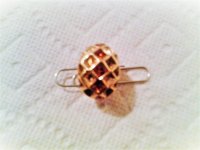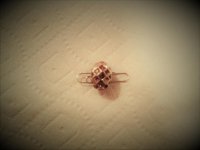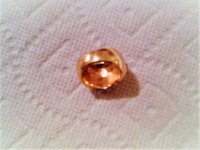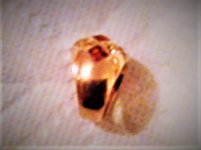ToddB64
Elite Member
Greetings ! 
Attached are some pictures of a gold ring that my brother found in a parking lot and gave to me. It looks like inexpensive costume jewelry and probably a girls ring judging by the small-size 22/32" (0.6875") inside diameter I measured with a stainless steel pocket ruler. I've done some testing that leads me to believe it's probably gold plated base metal and not worth much due to the low karate. Nevertheless, I would like to determine the approximate value before sending it to a refinery with other finds for a payout percent of the melt value. Perhaps the following information will assist you in making suggestions that might help me determine the ring's identity and value.
Presumably, this ring was hit by a tire judging from the edge damage on one side and some scratches. It has (19) cavities for stones, but only (5) brown stones are left intact and probably just cheap glass. The other (14) stones are missing. However, for a piece of costume jewelry the Gold-color is still very bright, as you can see from the attached pictures. The only identifying mark on this ring is a capital letter J stamped on the inside - bottom of the ring.
Using my test kit with a black rub stone and three acids,18K, 14K and 10K, I judged the acid reaction to indicate 10K, or just a little below. I don't have 9K acid at the moment for further testing.
I filed a groove approx. 1/64" (0.016") deep into the bottom edge of the ring on the damaged side and still didn't see the silver-gray color of a base metal, so the plating is fairly thick. One source on the Internet says that the plating on 10K GF Jewelry must equal 1/10 of the total weight of the item. Using my electronic pocket scale, the ring weighs 0.51 Avoir oz , 0.46 oz.Troy, 14.5 grams, 9.32 dwt.. So using the Troy weight, that would be (0.1 x 0.46) = 0.046" or 3/64" thick plating.
Since the Density of metals in a Periodic Table are based on pure metals, I didn't bother doing an Archimedes water displacement test for density, as the results would only be a rough approximation. Also, I don't know the other metals used to make this ring or the percent of each, which would be required to do a more accurate density calculation using mathematical formula. Anyway, I believe most people these days use acid testing, so that's what I did.
I also tied a piece of South Bend M144, 4lb test Monofilament fishing line, measuring 0.0079" thick with my micrometer, to a Neodymium computer hard drive magnet, and held the other end of this line in one of my hands and allowed the magnet to settle in the air. Then holding the ring with the fingers of my other hand, I moved the ring very slowly toward the magnet and the magnet swung slowly toward the ring and gently stuck. This tells me there is some ferrous element (iron) in the base metal of this ring, but the Gold plating is of sufficient thickness to mask most of the magnetic lines of force, at least that's my hypothesis.
ToddB64

Attached are some pictures of a gold ring that my brother found in a parking lot and gave to me. It looks like inexpensive costume jewelry and probably a girls ring judging by the small-size 22/32" (0.6875") inside diameter I measured with a stainless steel pocket ruler. I've done some testing that leads me to believe it's probably gold plated base metal and not worth much due to the low karate. Nevertheless, I would like to determine the approximate value before sending it to a refinery with other finds for a payout percent of the melt value. Perhaps the following information will assist you in making suggestions that might help me determine the ring's identity and value.
Presumably, this ring was hit by a tire judging from the edge damage on one side and some scratches. It has (19) cavities for stones, but only (5) brown stones are left intact and probably just cheap glass. The other (14) stones are missing. However, for a piece of costume jewelry the Gold-color is still very bright, as you can see from the attached pictures. The only identifying mark on this ring is a capital letter J stamped on the inside - bottom of the ring.
Using my test kit with a black rub stone and three acids,18K, 14K and 10K, I judged the acid reaction to indicate 10K, or just a little below. I don't have 9K acid at the moment for further testing.
I filed a groove approx. 1/64" (0.016") deep into the bottom edge of the ring on the damaged side and still didn't see the silver-gray color of a base metal, so the plating is fairly thick. One source on the Internet says that the plating on 10K GF Jewelry must equal 1/10 of the total weight of the item. Using my electronic pocket scale, the ring weighs 0.51 Avoir oz , 0.46 oz.Troy, 14.5 grams, 9.32 dwt.. So using the Troy weight, that would be (0.1 x 0.46) = 0.046" or 3/64" thick plating.
Since the Density of metals in a Periodic Table are based on pure metals, I didn't bother doing an Archimedes water displacement test for density, as the results would only be a rough approximation. Also, I don't know the other metals used to make this ring or the percent of each, which would be required to do a more accurate density calculation using mathematical formula. Anyway, I believe most people these days use acid testing, so that's what I did.
I also tied a piece of South Bend M144, 4lb test Monofilament fishing line, measuring 0.0079" thick with my micrometer, to a Neodymium computer hard drive magnet, and held the other end of this line in one of my hands and allowed the magnet to settle in the air. Then holding the ring with the fingers of my other hand, I moved the ring very slowly toward the magnet and the magnet swung slowly toward the ring and gently stuck. This tells me there is some ferrous element (iron) in the base metal of this ring, but the Gold plating is of sufficient thickness to mask most of the magnetic lines of force, at least that's my hypothesis.
ToddB64
Attachments
Last edited:





